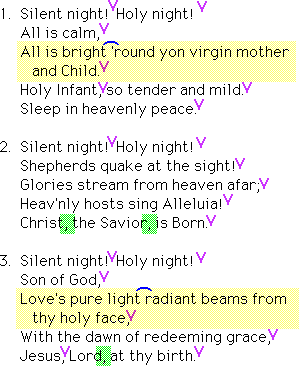Phrasing Text with Tune
The textual and musical phrasing may conflict. When this happens, usually the text should prevail. This may lead someone in the congregation to suddenly understand a message in a text that he may have sung for years, but never really understood.
The meaning of the text in verses 1 and 3 of “Silent Night” is much clearer when no break is made between “bright” and “round,” or between “light” and “radiant” (see blue slurs). You might use a reminder in the score not to break, such as a slur.
The text reads, “all is bright [a]round yon virgin mother and child,” not “all is bright, [pause] round yon . . . .” Verse 3 says, “love's pure light radiant [read, 'love's pure radiant light'] beams from thy holy face,” not “love's pure light, [pause] radiant beams from . . . .” The text does break at that point in verse 2.
